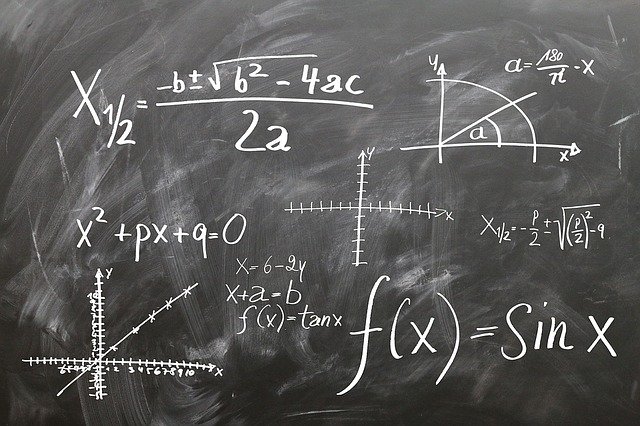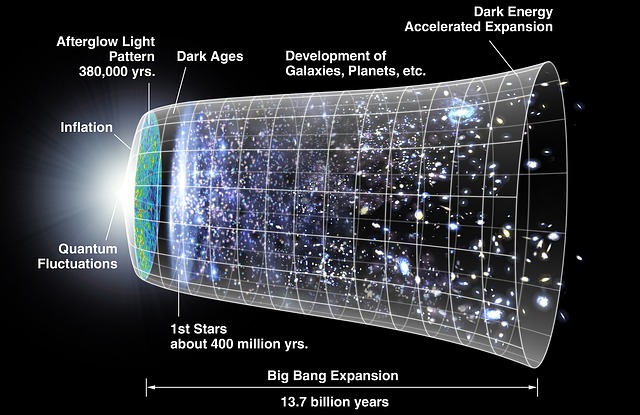The need to understand our environment and, therefore, ourselves has driven thinkers and scientists in all eras of history to decipher one of the most intricate unknowns about our existence: the origin of the universe
What is the universe origin?. When and how was he born?
Since the beginning of philosophical thought and the first sciences of our civilization, more than 3500 years ago in Sumerian, Egypt and ancient Greece, there have been thousands of thinkers who have tried, by any means, to discover what is the origin of the universe.
Theories about Universe Genesisl, as the evolution and origin of the universe, are very varied and depend on theoretical principles that have not yet been completely unified, therefore they have branched out into different aspects over the years.
For example: some theories start from the beginning of the Stationary Universe, that is, the assumption that the entire universe was born in the shape and size it is today. On the other hand, the theory of Inflationary Universe it lets us assume that the universe is constantly expanding, pushing galaxies away from each other and constantly creating new ones.
Origin of the Universe Theories in Antiquity
LSumerianos
Despite their poor understanding of the dynamics of the universe, the Sumerians marveled at the origin of the stars, to the point where astronomy became a kind of obsession for them.
In fact, from this, one of the first civilizations known to man, a relationship between the heavenly bodies and human behavior was already considered, which today has evolved in astrological beliefs.
In fact, it was the Sumerians who identified the 12 constellations through which the sun moves throughout the year and gave it the names of animals, for which it later became known as the zodiac.
Although they never proposed an acceptable theory of universal genesis (they believed that the universe floated on a sea called Nammu). the Sumerians set an important precedent for future theses about the composition of our Solar System in other civilizations.
Mainly because they managed to identify the most visible planets from Earth: Mars, Venus, Mercury, Jupiter and Saturn.
Origin of the Universe according to the Egyptians
Even today, the depth of the astronomical knowledge of the Egyptians It remains a mystery to us, what we do know for sure is that they possessed knowledge that was not transmitted.
For example, the exact alignment of the pyramid of giza with pole star It goes beyond all possible causality. In fact, they used the study of the stars for navigation and to accurately calculate the duration of the seasons.
However, beyond this mysterious knowledge, the Egyptians never raised a theory about the origin of the universe that it went beyond its own mythology and legends founded on the God Ra.
Origin of the Universe according to the Griegos
The theories, thoughts and discoveries made in Sumer and Egypt in previous centuries, were inherited by the most outstanding greek thinkers as a basis for his studies and subsequent theses.
In ancient Greece, theories about how the universe was created were very varied, in fact, some philosophers defended the widely accepted geocentric theories, as Ptolemy, whose theory was accepted and taught in universities for the next 1500 years.
Others, well ahead of their time, were already beginning to speak the heliocentric theory, which, as you already know, was rejected during the following centuries by the Catholic Church.
One of the greatest theoreticians of astronomy in Greece was Aristarchus of Samos, who, in addition to being the first to propose that our solar system revolves around the sun and not to The earth, was also the first to make acceptable calculations to measure the distance between the earth and the sun.
Moreover, Aristotles, Basing himself on the divinity of the spherical form, the most perfect of figures, according to him, he proposed that The Earth was actually spherical in shape and not flat., as had always been believed. Another theory very advanced in its time, which, as history also tells us, was rejected for more than a thousand years.
Nicolaus Copernicus theory
Nicolaus Copernicus was a Polish astronomer and scholar who completely overturned the conception of world genesis due to his controversial theory Heliocentric, which earned him the repudiation of the scientific and religious community in Europe, which at that time was governed by the Ptolemy's Geocentric theory (a thesis that at that time was 1300 years old).
In Copernicus's conclusions, drawn from several years of astronomical study, he proposed that, just as Aristarchus of Samos believed, the Earth and other celestial bodies revolve around the Sun and not the other way around.
Despite the fact that, at that time, in the XNUMXth century, the Copernican theory it was very controversial and, in fact, prohibited from being disseminated by the Catholic Church, only a century later it became the most widely accepted thesis on a global level.
The mathematical proof of the Heliocentric theory of Copernicus It opened the doors for the scientific community to achieve a much broader understanding of the dynamics of our solar system and the universe.
This progressive compression paid off, which, together with the technological advances of the XNUMXth century, has allowed physicists and astronomers to begin to speculate on a scientific basis about the creation of the universe.
Albert Einstein's theory

Albert Einstein is, today, recognized as the most influential physicist in history, mainly for his contribution to science with the Theory of Universal Relativity in 1915, in which he related the deformations in the displacement of light in relation to the gravitational fields of matter
Although the general belief is that the famous is that the Einstein's Theory of Relativity did not really seek to decipher the origin of the universe, but the nature of its mechanics, its equations were the cornerstone on which the expansion theory of the universe was based, confirmed by Edward Hubble only a few years later, in 1930.
The basic concept of Einstein's theory tells us that the perception of universal events is not invariable as Newton proposed, but is deformed according to the perception of the receiver in relation to its position in the universe. tiempo and space.
He also demonstrated with the variation of the general relativity that, the displacement of time and light are affected by the gravitational fields of matter according to its density, which helped to pose the space-time curvature concept and understand cosmic phenomena such as wormholes.
So denser clumps of matter, like neutron stars, which concentrate a greater number of particles in a smaller space, are capable of generating much more intense gravitational fields, capable of creating a deformation of the space and time line of the universe.
Big Bang Theory
The conception of Origin Of The Big Bang Universe, also known as the Big Bang Theory, has been developed thanks to the validation of several theses and the joint work of some of the greatest astrophysicists in history, hence it is the theory about the origin of the universe more widely accepted by the scientific community.
The Big Bang suggests that the universe was born from a gravitational singularity at some point before known time, about 13.800 million years ago (which would be the estimated age of our universe).
be understood as Singularity an event of space time that it cannot be governed by the physical rules of matter, in this case, the behavior of energy or matter would be governed by rules of quantum physics, for which there is still no supporting thesis.
Therefore, from this point on it becomes difficult for physics to explain the circumstances that could have given rise to the Big Bang in the first place, or to any other dimension of existence before this point, where it begins Weather. In fact, this is a dimension that tries to explain itself in the stationary universe theory.
El Big Bang was then an explosion in which the elements that make up the universe were created (matter, space and time) and, that from the moment of the singularity are in permanent expansion, expanding the limits of the universe second by second (basic principle of inflationary theory).
But what existed before the Big Bang?
As we have mentioned, it is impossible to understand, through the laws that govern our universe (explained by the theory of general relativity), the conditions of a hypothetical existence before the event that created our universe as we know it.
However, the same theory Big Bang suggests that, immediately after the explosion, all the mass of the universe was accumulated in a point of hyper-concentrated density, which would exceed by thousands of times the planck Density, that is, the accumulation of the matter of hundreds of thousands of solar masses within a point no larger than a single atomic particle.
For the next 500.000 years after the first spatiotemporal singularity, matter ejected by the explosion shifted, widening space and cooling enough to start forming the first stable atomic particles, whose mass was capable of generating gravitational fields.
The first subatomic particles created during this period (Lepton-Quark era) were the Protons and Neutrons that when united, they begin to form the matter as we know it today.
The particles of matter with physical properties began to attract and accumulate thanks to the gravitational property (explained in Einstein's theory of relativity), in what we now know as Cosmic Clouds.
The hyper condensation of gaseous masses of cosmic clouds gave way to the formation of first galaxies, along with the stars and planets they contain.
For example, it is estimated that our solar system formed about 4600 billion years ago from the collapse of a giant cosmic cloud.
A large part of the mass shed during the collapse accumulated, giving way to the formation of our only sun. The rest of the fired matter gave way to the formation of the Planets that currently orbit around the gravitational field of our star.
Steady state theory
steady state It is a theory opposed to the theory of inflationary universe, in which it is stated that our universe has a fixed dimension, that it does not change through time and that, in fact, it is completely invariant from any point in space and time.
Thus, the universe must always show the same characteristics in terms of shape and dimension for viewers regardless of their location in space or on the timeline.
This theory accepts that universe is constantly expanding and that the loss of matter produced by the expansion is compensated by the creation of new matter at a parallel rate, achieving a perfect cycle of creation, in a universe that has no beginning or end.
However, acceptance of stationary theory calculations would render obsolete many of the currently accepted theories and validated studies, including Hubble's early XNUMXth century demonstrations and the principles of general relativity.
Despite that no experiment has managed to demonstrate fundamental principles of stationary theory, many modern scientists continue to work on it, in the belief that with modifications to the quantum scale of Einstein's equations, it would be possible to explain a model of the universe in reverse time, that is, the existence of matter similar to ours before of the creation of time as we know it.
According to a study titled "A finite Universe, without beginning or end" submitted by physicist peter lynds in 2007, he suggested that the existence of the universe is cyclical and that it is in constant rebirth.
According to this assumption, the universe will expand to a maximum point, and then begin to contract matter to a point of density that causes gravitational forces to repel each other instead of attracting each other, generating a new point of expansion.
